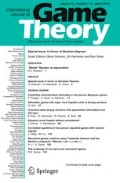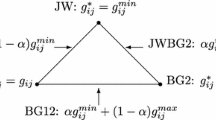Abstract
In this paper we show how externalities between links affect the existence and uniqueness of pairwise stable (PS) networks. For this we introduce the properties ordinal convexity (concavity) and ordinal strategic complements (substitutes) of utility functions on networks. It is shown that there exists at least one PS network if the profile of utility functions is ordinal convex and satisfies the ordinal strategic complements property. On the other hand, ordinal concavity and ordinal strategic substitutes are sufficient for some uniqueness properties of PS networks. Additionally, we elaborate on the relation of the link externality properties to definitions in the literature.
Similar content being viewed by others
References
Bala V, Goyal S (2000) A noncooperative model of network formation. Econometrica 68(5): 1181–1230
Billand P, Bravard C, Sarangi S (2011) Local spillovers, convexity and the strategic substitutes property in networks. Departmental Working Papers 2011-01, Department of Economics, Louisiana State University, Baton Rouge
Bloch F, Jackson M (2006) Definitions of equilibrium in network formation games. Int J Game Theory 34(3): 305–318
Bloch F, Jackson MO (2007) The formation of networks with transfers among players. J Econom Theory 133(1): 83–110
Buechel B, Hellmann T (2012) Under-connected and over-connected networks: the role of externalities in strategic network formation. Rev Econom Des 16: 71–87
Calvó-Armengol A, Ilkiliç R (2009) Pairwise-stability and Nash equilibria in network formation. Int J Game Theory 38(1): 51–79
Chakrabarti S, Gilles R (2007) Network potentials. Rev Econom Des 11(1): 13–52
Dutta B, Mutuswami S (1997) Stable networks. J Econom Theory 76(2): 322–344
Gilles R, Sarangi S (2005) Stable networks and convex payoffs. Discussion Paper 2005-84, Center for Economic Research, Tilburg University, Tilburg
Goyal S, Joshi S (2006a) Bilateralism and free trade. Int Econom Rev 47(3): 749–778
Goyal S, Joshi S (2006b) Unequal connections. Int J Game Theory 34(3): 319–349
Goyal S, Vega-Redondo F (2007) Structural holes in social networks. J Econom Theory 137(1): 460–492
Jackson MO, Watts A (2001) The existence of pairwise stable networks. Seoul J Econom 14(3): 299–321
Jackson MO, Wolinsky A (1996) A strategic model of social and economic networks. J Econom Theory 71(1): 44–74
Monderer D, Shapley LS (1996) Potential games. Games Econom Behav 14: 124–143
Author information
Authors and Affiliations
Corresponding author
Rights and permissions
About this article
Cite this article
Hellmann, T. On the existence and uniqueness of pairwise stable networks. Int J Game Theory 42, 211–237 (2013). https://doi.org/10.1007/s00182-012-0335-9
Accepted:
Published:
Issue Date:
DOI: https://doi.org/10.1007/s00182-012-0335-9




